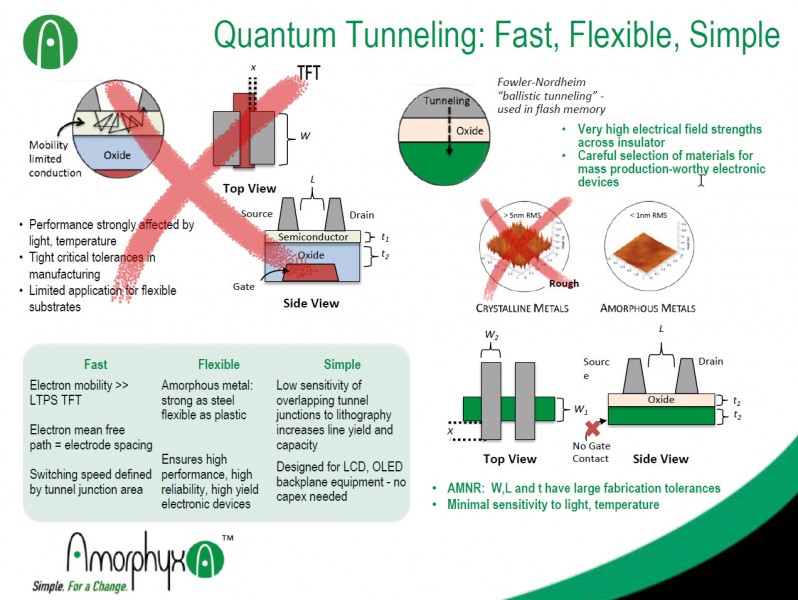 Amorphyx is a new company that is working on new technology for backplanes and the CEO is John Brewer who started by saying that TFTs have very bad performance and the industry needs to get beyond using amorphous silicon because the transistors will never be any good.
Amorphyx is a new company that is working on new technology for backplanes and the CEO is John Brewer who started by saying that TFTs have very bad performance and the industry needs to get beyond using amorphous silicon because the transistors will never be any good.
The company has developed a sample with BOE and uses quantum tunnelling (QT – and said to be the foundation of flash RAM) and the company is the first to use the technology. The key to correct operation is to get a smooth electrode that allows high quality devices. Electron mobility is a key driver of better displays, but no semiconductor is as good as quantum tunnelling (which was discovered nearly 100 years ago). The layout of the QT device is much simpler and less dimensionally fussy than transistors, which is a big advantage in making large displays.
The same diodes, transistors, resistors and capacitors can be made using QT rather than semiconductor materials. The technology can support voltages up to 50V.

The company comes from Oregon, but is fabless. It has no clean room because it doesn’t need one, but has worked with ITRI in Taiwan on research for a number of years. It is currently raising $3 million by the end of July. It’s not a science project, Brewer said, it’s ready to go into mass production. Amorphyx is also working on a bipolar transistor for radio applications.
There is no leakage current, so you can create blacker blacks, and the LC material can be more sensitive because the fields can be better controlled. As devices get bigger, they can get faster. Field sequential devices are no problem if the LC material is fast enough.
QT devices are claimed to be better than LTPS, but cheaper than amorphous and the process is of making them is done at room temperature. There is also low sensitivity to processing errors and the company has shown over 150K hours of use of a display. Bad mis-alignment issues can be easily fixed with the technology, unlike TFT.
The company’s plan is to license a single partner for each segment to allow each partner to be disruptive in its segment. There are lots of other applications as the transistor is not sensitive to light or temperature. That means that the switches can be directly coated by OLED materials which can improve the effective aperture ratio in top emission. High voltage with high speed is easy for the technology so EPD is really a natural application and even technology such as blue phase LCD could be resurrected as well as high speed LCDs for frame sequential LCDs.
The company is in the iZone showing an IPS display that it developed.
In response to questions, the company believes it may be able to halve the price of an LCD backplane and reduce LCD cost by 25%. It also believes it can double the capacity of a G10 fab – that’s a big change!
Analyst Comment
I’m fond of the phrase ‘if they can do what they say they can do’ and it applies in this case. My understanding of quantum physics is not good enough to really check the concept for ‘gotchas’. If the company is working with Itri, however, it must gain a lot of credibility. (BR)

